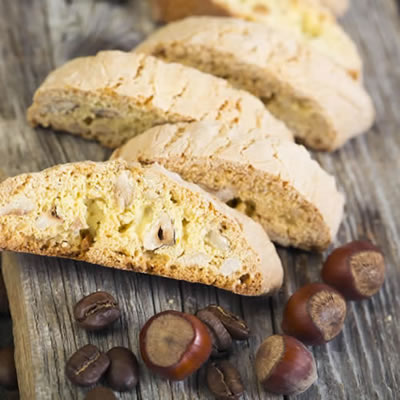
Biscotti
Also known as Cantucci
What is Biscotti?
Biscotti is a sliced cookie made from a long piece of dough that has been baked, cut into individual pieces and finally re-baked to obtain characteristic texture and low moisture.
The cookie is long and finger shaped. The double baking dries out the dough, giving it a crunchy texture. It is made in variety of flavors, and often with inclusions such as:
- Dried or fresh fruit
- Nuts
- Chocolate chunks or chips
Origin
Biscotti probably originated during the 15th century with an Italian baker who originally served them with Tuscan wines. They became so popular that each province within Italy developed its own version.
Biscotti is said to have been a favorite of Christopher Columbus and other sailors of the time because of their long shelf life. In Italian, the word biscotto means “biscuit” or “cookie.”
How biscotti is made
Formulation for a chocolate biscotti
Ingredient |
Baker’s % (based on flour weight) |
| Bread flour* | 100.0 |
| Granulated sugar | 70.0–75.0 |
| Liquid whole eggs | 45.0–50.0 |
| Chocolate chips or chunks** | 30.0–40.0 |
| Butter (refrigerated, plastic) | 20.0–30.0 |
| Almond flour | 10.0–20.0 |
| Natural cocoa (powder) | 10.0–15.0 |
| Vanilla extract | 4.0–5.0 |
| Baking powder | 2.0–3.0 |
| Salt | 1.0–2.0 |
Cookie flour may also be used.
**Nuts or dried fruit pieces can also be added.
Processing²
- Mixing
- Butter must be put aside and reserved for creaming with sugar.
- Liquids (vanilla and whole eggs) and solids must be combined and mixed independently.
- Creaming: Cream the butter and sugar until well combined.
- Add liquids to cream.
- Add solids to cream, mix until fully incorporated and a cohesive (not fully developed) dough is obtained.
- Add chocolate chips until fully incorporated.
- Dough forming: Form the dough into 2 lb 3 oz (1,000 g) logs (or finger shapes). Place on parchment-lined sheet pans and flatten to 1 inch (2.5 cm) height.
- Glazing: For a more glossy finished cookie, brush egg yolk and water on top of the dough before baking.
- First baking: Bake at 163°C (325°F) convection for 35 to 40 minutes, until firm to touch.
- Cooling: Remove biscottis from the oven and cool for 40 minutes at room temperature.
- Slicing: Cut on a bias and return slices to the sheet pan
- Second baking: Rebake the biscotti at 121°C (250°F) until well dried. A shiny look from recrystallized sugar appears on the surface of biscotti.
Application
Cookie flour is more suitable than bread flour. A cookie flour for biscotti production has 53% water absorption in the Farinograph test. Most cookie flours are selected from hard and soft wheat blends which render a final wet gluten amount of about 22%. In case of switching from bread to cookie flour, it is important to bear in mind that a lower amount of liquid eggs (or water) may be needed to obtain equivalent dough consistency.
Crunchiness of biscotti
It is crucial to fully dry out the dough during baking, in order to get that crunchy quality. If there is higher humidity, that may extend the baking time. To keep the characteristic crispness, store in an airtight container.
References
- Suas, M. “Cookies.” Advanced Bread and Pastry: A Professional Approach, Delmar, Cengage Learning, 2009, pp. 422–423.
- The Culinary Institute of America. “Cookies.” Baking and pastry, mastering the art and craft, John Wiley & Sons, Inc., 2016, pp. 335–336.

